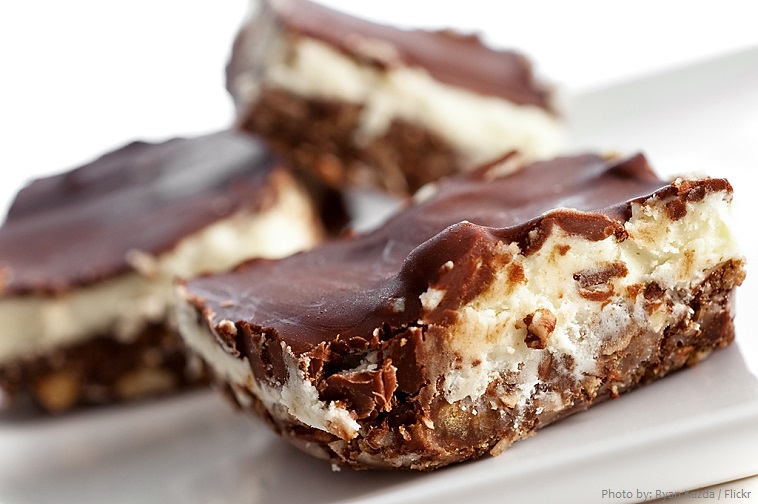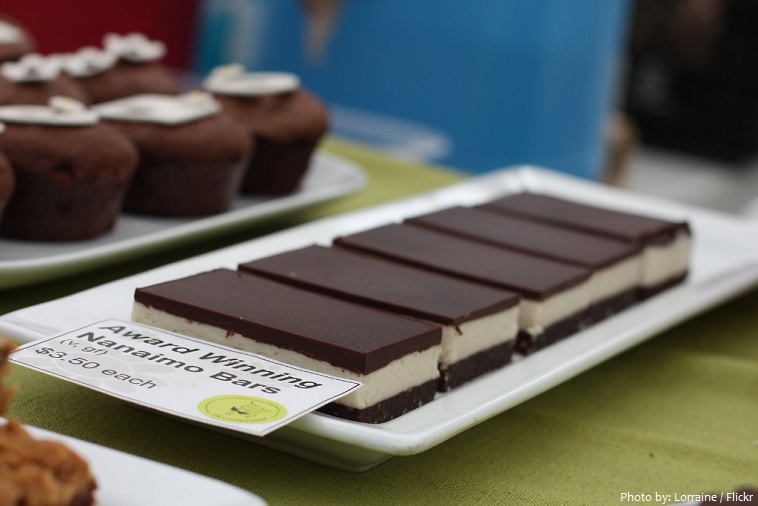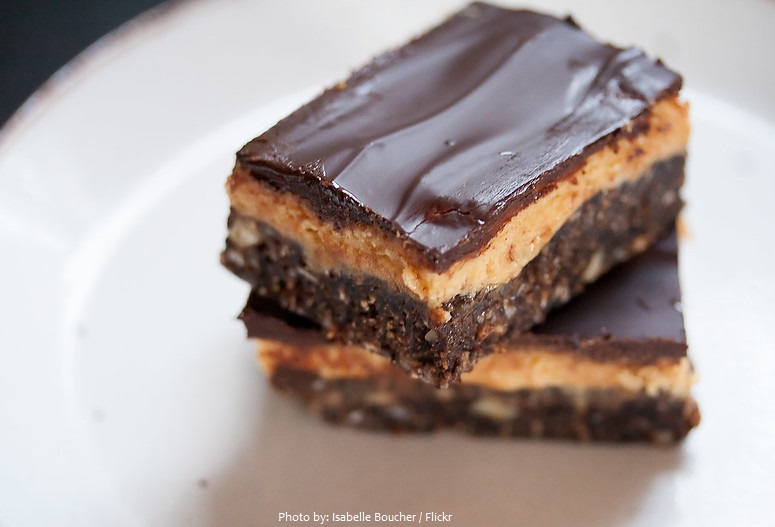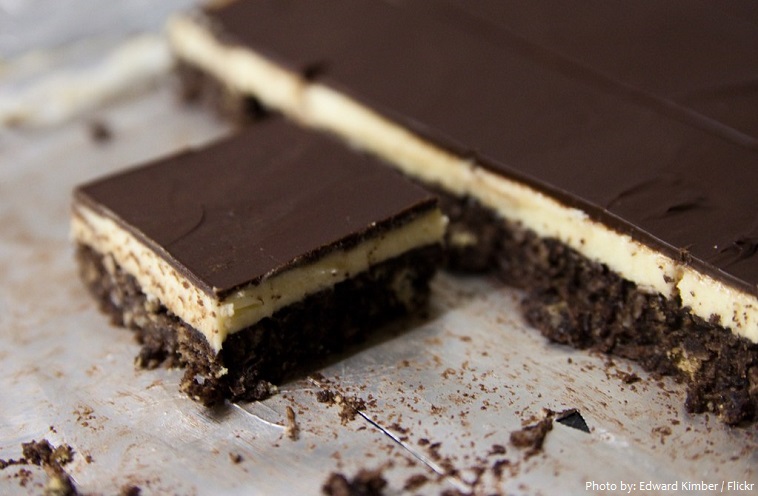
The Nanaimo bar is a no-bake dessert that traditionally consists of three layers.
It looks something like a geological cross section. Its base is sedimentary: coconut and chopped walnuts bound together by a buttery silt of cocoa and crushed graham crackers. A middle layer of yellow buttercream teeters on the brink of liquefaction. And its top crust of chocolate, hard and brittle, thaws like the Arctic tundra the longer it lingers at room temperature.
Many varieties exist, consisting of various types of crumb, various flavours of icing (such as peanut butter or coconut, mocha), and various types of chocolate.

The dessert is named after the city of Nanaimo, British Columbia. It is known as “The Harbour City”. The city was previously known as the “Hub City”, which has been attributed to its original layout design where the streets radiated out from the shoreline like the spokes of a wagon wheel, as well as its generally centralized location on Vancouver Island.
There is a long tradition of no-bake desserts, dating back to the beginning of the Common Era when Marcus Gavius Apicius described making a jelly with bread crumbs soaked in wine and cheese, and chilled in snow. More recent is the English trifle, made of stale sponge cake brushed with liquor, layers of custard and jam, with cream on top, which dates back to at least the late 16th century.

No-bake desserts such as the Nanaimo bar grew in prominence due to the cultural mores of postwar North America. In her book Baking as Biography, Diane Tye notes that expensive and time-consuming dainties were considered a status symbol.
The first known recipe for Nanaimo bars appeared in the 1952 Women’s Auxiliary of the Nanaimo Hospital Cookbook and was labelled “chocolate square.”
The earliest copy of the recipe using the name “Nanaimo bars” appears in the Edith Adams’ prize cookbook (14th edition) from 1953. However, following research into the origins of Nanaimo bars, Lenore Newman writes that the same recipe was published in the Vancouver Sun earlier that same year under the name “London Fog Bar”. The recipe later also appears in the publication His/Her Favourite Recipes, Compiled by the Women’s Association of the Brechin United Church (1957), with the recipe submitted by Joy Wilgress, a Baltimore, Maryland, native. (Brechin United Church is in Nanaimo.)

Susan Mendelson is perhaps most responsible for commercializing the Nanaimo bar. She sold the bar during the 1970s to help pay her tuition, and in 1979 founded The Lazy Gourmet, a cafe and catering company in Vancouver, which claims to be the first business to sell the dessert.
The popularity of the bar in Nanaimo led local residents to mobilise to have it voted “Canada’s Favourite Confection” in a National Post reader survey. In 1985, Mayor Graeme Roberts initiated a contest to find the ultimate Nanaimo bar recipe. The recipe submitted by Joyce Hardcastle, a resident of Nanaimo, was unanimously selected by a panel of judges.
The Nanaimo bar was popularized nationwide after being highlighted as a classic Canadian dessert at Expo 86.
Recipes for similar desserts are found in various places, under various names, in North America and Europe. The designation “Nanaimo bar” is Canadian, and appears in the Canadian Oxford Dictionary, but not in other language or dialect versions.

Following a 2006 poll, the National Post declared the Nanaimo bar Canada’s favourite confection, beating out offerings such as Coffee Crisp, Beaver Tails, Cherry Blossoms, McCain’s Deep’n Delicious cake, Jos Louis, Tim Hortons’ Iced Capp, and Laura Secord chocolate.
In April 2019, Canada Post announced the release of a booklet of postage stamps dedicated to Canadian desserts and sweets. The booklet of 10 stamps features images of the Nanaimo bar, the butter tart, tarte au sucre (sugar pie), blueberry grunt, and Saskatoon berry pie. Canada Post described the stamps as “fun-shaped”, and the booklet of stamps resembled a recipe card. The image of the Nanaimo bar on the stamp received some criticism for its ratio of “the crumbly base, the custard filling, and the chocolate ganache
icing.
The largest Nanaimo bar is 240.94 kg (531.178 lbs) and was achieved by Ella Kurtis and Austin Kurtis (both Canada) in Levack, Ontario, Canada, on 5 March 2020. Ella and Austin Kurtis were looking to create the largest of this Canadian dessert, while also raising funds for a local splash pad committee in Ontario.

Nanaimo Bar Recipe:
• Bottom Layer
1/2 cup unsalted butter (European style cultured) (125 ml)
1/4 cup sugar (50 ml)
5 tbsp. cocoa (75 ml)
1 egg beaten
1 3/4 cups graham wafer crumbs (425 ml)
1/2 cup finely chopped almonds (125 ml)
1 cup coconut (250 ml)
Melt first 3 ingredients in top of double boiler. Add egg and stir to cook and thicken. Remove from heat. Stir in crumbs, coconut, and nuts. Press firmly into an ungreased 8″ x 8″ pan.
• Second Layer
1/2 cup unsalted butter (125 ml)
2 Tbsp. and 2 Tsp. cream (40 ml)
2 Tbsp. vanilla custard powder (30 ml)
2 cups icing sugar (500 ml)
Cream butter, cream, custard powder, and icing sugar together well. Beat until light. Spread over bottomlayer.
• Third Layer
4 squares semi-sweet chocolate
2 Tbsp. unsalted butter (30 ml)
Melt chocolate and butter over low heat. Cool. Once cool, but still liquid, pour over second layer and chill in refrigerator.